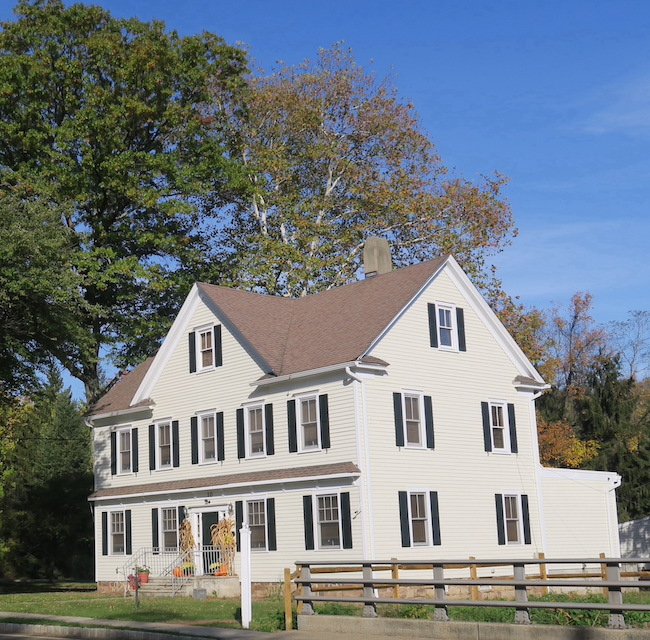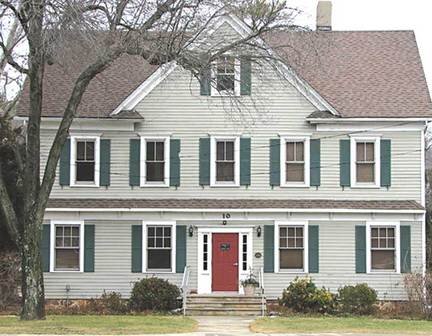Henry proudly served in the U.S. Army Air Corps, 15th Air Force, in World War II, as his father did in World War I. He was a man of peace who fought against tyranny. Henry set the Air Force flying record by completing 50 combat missions in 65 days. He volunteered and was selected by Major Ascani to fly in the lead plane on a Top Secret Classified Mission into Nazi occupied Czechoslovakia to support the Slovak National Uprising. His crew landed behind enemy lines to bring supplies and rescue flyers and leaders of the uprising. This heroic act earned him a Distinguished Flying Cross, many years after the mission was declassified, as well as honorary citizenship by the President of Slovakia.
One of the largest updates is that related to World War I & II displays with a spotlight on World War II Veteran and Watchung resident Henry Long. Jason Ng, Eagle Scout candidate worked closely with scouts, historical committee members, and other local volunteers to create this impressive display.
from “Historical Committee” column in 2021 Borough of Watchung Fall/Winter Newsletter
from Nov 14, 1999 Courier news available at Plainfield Public Library
Henry Long
Henry Long is a Hometown Hero
Henry Long at 90
World War II hero Army Air Corps secret mission recalled from Echoes Sentinel
DENIS J. KELLY Nov 15, 2013
Long flew 50 combat missions in 65 days, amassing a total of 222 hours of flying time, flying B17s out of Italy. Italy had already been liberated when Long arrived, but the missions he flew often took heavy anti-aircraft fire, and fighter attacks. Many planes were lost, and many crewmen died or were taken prisoner.
Flying Cross
Long served as aviation engineer, bubble turret gunner, and back-up pilot. Long, and 29, other men were involved in a secret mission which came to be known as the Dawes Mission (page 18) only after information about the mission was declassified decades after World War II.
The mission flew out of Bari, Italy. Six B17s flew deep behind German lines, landing in Czechoslovakia. Long was picked by Maj. Gen. Fred Ascani to accompany him in the lead plane, Franklin said.
The mission was to carry in and unload weapons, ammunition and supplies for the Czechoslovakian partisans and resistance fighters. Then, they were to fly out with 35 downed flyers and three Czechoslovakian military representatives who were then to be ferried to London for a meeting there with Czechoslovakian government representatives.
It was Oct. 7, 1944, and the B17s were ordered to fly at tree tops so as not to be detected by German radar. They were met and accompanied by Mustang fighters and Red Tails, piloted by the Tuskegee Airmen, the legendary squadron of African-American pilots.
The landing was expected to be challenging, on a grassy German airfield, since no nearby hardtop runways were available. A diversion was created, which enticed the German planes at the airstrip off the ground to chase the diversion, and Czechoslovakian partisans were waiting around the border of the airfield to chase off any Germans who might have been left on the ground.
The American bombers landed, and the Czech partisans held off the Germans on the ground, who had returned and attempted to retake the field.
A firefight raged all around the bombers, as crews hustled to unload the weapons and supplies. It took an hour, but the B17s were successfully unloaded. Their take off had to be delayed slightly when one of the bombers landing gear became mired in the soft ground. The partisans worked feverishly to tow the plane to harder ground, and the three Czech partisans came aboard the lead plane, Long’s plane, for the ride back to Italy, Franklin said.
In addition to the munitions and supplies, some American officials with the Office of Strategic Service (OSS), the forerunner of the Central Intelligence Agency, CIA) remained behind to support the partisans. An American war correspondent attached to the partisans would later report that many of the partisans were hunted down and executed by the Germans because they had helped the Americans. Some nurses who had aided the partisans in a village met the same fate.
The men that carried out the Dawes Mission, including Long, were recommended for the Distinguished Flying Cross, an honor surpassed only by the Congressional Medal of Honor, Franklin said. They also received the heartfelt thanks and praise of the prisoners they liberated.
The citation accompanying the Distinguished Flying Cross reads:
“Technical Sgt. Henry Long distinguished himself by extraordinary achievement while participating in aerial flight on a secret mission to Tri Duby Airport, Czechoslovakia, on 7 Oct. 1944. On that date, as engineer, 483rd Bombardment Group, he and his crewmembers displayed superior skill and coordination, materially aiding in the successful completion of this mission.”
Long said he kept the secret of the Dawes Mission for 55 years after the war, because it was a classified mission, and he was sworn to secrecy.
Finally, in 1999, the mission was unclassified, and Long was awarded the Distinguished Flying Cross. When Slovakian representatives found out about the mission all those years later, they invited Long and the other surviving members of the Dawes Mission, to visit Slovakia and take part in the 55th anniversary of the Slovakian National Uprising, Franklin said.
Likewise, the Air Force notified Long that he would be awarded the Distinguished Flying Cross, and recommended that it be given to him when he visited Slovakia. While in Slovokia to receive that honor, Long was also given numerous awards from Slovokia. And was made an honorary citizen of the country.
A photo of Long’s plane along with photos of the three Slovakian military leaders ferried by the Dawes Mission, remain permanently on display at the Museum of the Slovakian National Uprising.
The Dawes Mission appears prominently in Slovakian history books, and is taught to Slovakian school children.




